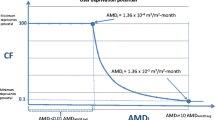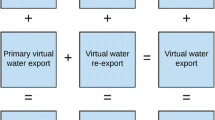Abstract
The continuously growing population in combination with the escalating urbanization and economic growth increase the pressure on water, energy and food resources of our planet. This entails an urgent need for proper water resources management within the water-energy-food (WEF) nexus concept. The WEF nexus considers water, energy and food as three continuously interconnected sectors, whose complex interactions lead to an increased number of trade-offs and potential conflicts. Computational modeling can be used to quantify these interactions, reduce trade-offs and promote synergies. We investigate the water resources in the Upper Blue Nile River (UBNR) basin, one of the two main sources of the Nile, using the Hydronomeas tool. Hydronomeas is based on the parameterization-simulation-optimization method; optimization is implemented in two levels, using a holistic approach and multiple criteria. We assign various targets, constraints and priorities to the UBNR system of reservoirs, hydropower plants and irrigation projects and derive a Pareto front that contains alternative, optimal solutions, for which improvement of one objective can be achieved only at the expense of another. By visualizing the trade-offs between the conflicting objectives of hydropower and irrigation, we aim to help decision makers understand changes due to different management policies and thus, achieve greater efficiency in water resources management in the Nile region.




Similar content being viewed by others
References
Awulachew SB, Merrey DJ, Kamara AB, van Koppen B, Penning de Vries F, Boelee E, Makombe G (2005) Experiences and opportunities for promoting small-scale/micro irrigation and rainwater harvesting for food security in Ethiopia, IWMI working paper 098. IWMI, Colombo. https://doi.org/10.3910/2009.277
BCEOM, BRGM, ISL (1998) Abbay river basin integrated development master plan project. Ministry of Water Resources, Federal Democratic Republic of Ethiopia
Bieber N, Ho Ker J, Wanga X, Triantafyllidis C, van Dam KH, Koppelaard HEMR, Shah N (2018) Sustainable planning of the energy-water-food nexus using decision making tools. Energy Policy 113:584–607
Biggs EM, Bruce E, Boruff B et al (2015) Sustainable development and the water-energy-food nexus: a perspective on livelihoods. Environ Sci Pol 54:389–397
Block P, Strzepek K (2010) Economic analysis of large-scale upstream river basin development on the Blue Nile in Ethiopia considering transient conditions, climate variability, and climate change. J Water Resour Plan Manag 136(2):156–166
Cascão AE (2012) Nile water governance. In: Awulachew SB, Smakhtin V, Molden D, Peden D (eds) The Nile river basin. Water, agriculture, governance and livelihoods. Routledge, New York, pp 269–291
Celeste AB, Billib M (2009) Evaluation of stochastic reservoir operation optimization models. Adv Water Resour 32(9):1429–1443
Chang LC, Chang FJ (2009) Multi-objective evolutionary algorithm for operating parallel reservoir system. J Hydrol 377:12–20
Cheikh M, Jarboui B, Loukil TC, Siarry P (2010) A method for selecting Pareto optimal solutions in multiobjective optimization. J Inf. Math Sci 2(1):51–62
Digna RF, Mohamed YA, van der Zaag P, Uhlenbrook S, Corzo GA (2017) Nile river basin modelling for water resources management – a literature review. Int J River Basin Manag 15(1):39–52
Efstratiadis A, Koutsoyiannis D, Xenos D (2004) Minimizing water cost in the water resource management of Athens. Urban Water J 1(1):3–15
Erlich H (2002) The cross and the river: Ethiopia, Egypt, and the Nile. Lynne Rienner. Publishers, London
FAO (2018) http://www.fao.org/energy/water-food-energy-nexus/en/. Accessed 20 June 2018
FAO (Food and Agriculture Organization) (2014) The water-energy-food nexus, a new approach in support of food security and sustainable agriculture, issue paper. FAO, Rome
Georgakakos AP (2006) Decision support systems for water resources management: Nile basin applications and further needs. In: CPWF proceedings of the working conference, Nazareth. IWMI, Addis Ababa
Goor Q, Halleux C, Mohamed Y, Tilmant A (2010) Optimal operation of a multipurpose multireservoir system in the eastern Nile river basin. Hydrol Earth Syst Sci 14(10):1895–1908
Hassaballah K, Jonoski A, Popescu I, Solomatine DP (2012) Model-based optimization of downstream impact during filling of a new reservoir: case study of Mandaya/Roseires reservoirs on the Blue Nile river. Water Resour Manag 26(2):273–293
Hoff H (2011) Understanding the nexus, background paper for the Bonn2011 Conference: The water, energy and food security nexus. Stockholm Environment Institute (SEI), Stockholm
ITIA (2018) http://www.itia.ntua.gr/en/projinfo/180/. Accessed 20 June 2018
Jeuland M, Whittington D (2014) Water resources planning under climate change: assessing the robustness of real options for the Blue Nile. Water Resour Res 50(3):2086–2107
King A, Block P (2014) An assessment of reservoir filling policies for the grand Ethiopian renaissance dam. J Water Clim Chang 5(2):233–243
Koukouvinos A, Nikolopoulos D, Efstratiadis A et al (2015) Integrated water and renewable energy management: the Acheloos-Peneios region case study, poster. EGU General Assembly 2015. EGU, Vienna
Koutsoyiannis D, Economou A (2003) Evaluation of the parameterization-simulation-optimization approach for the control of reservoir systems. Water Resour Res 39(6):1170
Koutsoyiannis D, Efstratiadis A, Karavokiros G (2002) A decision support tool for the management of multi-reservoir systems. J Am Water Resour Assoc 38(4):945–958
Koutsoyiannis D, Karavokiros G, Efstratiadis A, Mamassis N, Koukouvinos A, Christofides A (2003) A decision support system for the management of the water resource system of Athens. Ph Chem Earth 28(14-15):599–609
Liu J, Yang H, Cudennec C, Gain AK, Hoff H, Lawford R, Qi J, de Strasser L, Yillia PT, Zheng C (2017) Challenges in operationalizing the water-energy-food nexus. Hydrol Sci J 62(11):1714–1720
McCartney MP, Girma MM (2012) Evaluating the downstream implications of planned water resource development in the Ethiopian portion of the Blue Nile river. Water Int 37(4):362–379
McCartney MP, Alemayehu T, Easton ZM, Awulachew SB (2012) Simulating current and future water resources development in the Blue Nile river basin. In: Awulachew SB, Smakhtin V, Molden D, Peden D (eds) The Nile river basin. Water, agriculture, governance and livelihoods. Routledge, New York, pp 269–291
Nalbantis I, Koutsoyiannis D (1997) A parametric rule for planning and management of multiple reservoir systems. Water Resour Res 33:2165–2177
NBI (1999) Policy guidelines for the Nile river basin strategic action program. NBI Secretariat and World Bank, Kambala
NBI (2016) Nile basin water resources atlas. Nile Information System. http://nileis.nilebasin.org/content/nile-basin-water-resources-atlas. Accessed 17 October 2017
Reddy MJ, Kumar DN (2006) Optimal reservoir operation using multi-objective evolutionary algorithm. Water Resour Manag 20:861–878
Sileet TM, El Shamy M, Sharaky A (2014) Downstream impact of Blue Nile basin development. Nile Basin Water Sci Eng J 7(1):16–33
Simonovic (1992) Reservoir systems analysis: closing gap between theory and practice. J Water Resour Plan Manag 118(3):262–280
Stamou AT, Rutschmann P (2016) Optimization of water resource use within the Blue Nile river basin, Ethiopia. Chair of Hydraulics and Water Resources Engineering, Technical University of Munich. http://www.freunde.wb.bgu.tum.de/en/symposium-2016/download-beitraege/ Accessed 25 August 2017
Stamou AT, Rutschmann P (2017) Towards the optimization of water resource use in the upper Blue Nile river basin. In: Tsakiris G, Tsihrintzis VA, Vangelis H, Tigkas D (eds) Panta Rhei. Proceedings of the 10th world congress of EWRA on water resources and environment. EWRA, Athens, pp 673–678
Wheeler KG, Basheer M, Mekonnen ZT, Eltoum SO, Mersha A, Abdo GM, Zagona EA, Hall JW, Dadson SJ (2016) Cooperative filling approaches for the grand Ethiopian renaissance dam. Water Int 41(4):611–634
Whittington D, Wu X, Sadoff C (2005) Water resources management in the Nile basin: the economic value of cooperation. Water Policy 7(3):227–252
Worldometers (2017) http://www.worldometers.info/world-population/. Accessed 22 November 2017
Wurbs RA (1993) Reservoir-system simulation and optimization models. J Water Resour Plan Manag 119(4):455–472
Yilma AD, Awulachew SB (2009) Characterization and atlas of the Blue Nile basin and its sub-basins. In: Awulachew, SB, Erkossa T, Smakhtin V, Fernando A (eds.) Improved water and land management in the Ethiopian highlands: its impact on downstream stakeholders dependent on the Blue Nile. IWMI, Colombo
Zhang Y, Erkyihum ST, Block P (2016) Filling the GERD: evaluating hydroclimatic variability and impoundment strategies for Blue Nile riparian countries. Water Int 41(4):593–610
Acknowledgements
A previous shorter version of the paper has been presented in the 10th World Congress of EWRA “Panta Rhei” Athens, Greece, 5-9 July 2017 (see Stamou and Rutschmann 2017).
The present study is part of the NIMA-NEX project, with main partners the Technical University of Munich, Germany and the University of Alberta, Canada.
The authors would like to thank the Ministry of Water Irrigation and Electricity of Ethiopia in Addis Ababa, the Abbay Basin Authority as well as ENTRO and the IWMI for providing some of the main data and information for the present study.
Funding
This study was funded by the German Research Foundation (GSC 81, International Graduate School of Science and Engineering).
Author information
Authors and Affiliations
Corresponding author
Ethics declarations
Conflict of Interest
The authors declare that they have no conflict of interest.
Rights and permissions
About this article
Cite this article
Stamou, AT., Rutschmann, P. Pareto Optimization of Water Resources Using the Nexus Approach. Water Resour Manage 32, 5053–5065 (2018). https://doi.org/10.1007/s11269-018-2127-x
Received:
Accepted:
Published:
Issue Date:
DOI: https://doi.org/10.1007/s11269-018-2127-x




